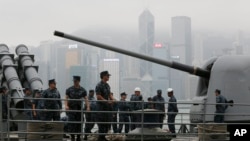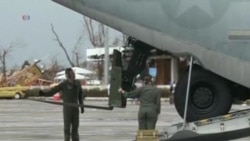The U.S. Navy has sent a Japan-based aircraft carrier strike group to the Philippines to step up relief efforts following the devastating typhoon Haiyan. The record-setting storm is estimated to have killed more than 10,000 people and left hundreds of thousands in need of food, water, shelter, and medical care. The Navy ships are well-equipped for disaster relief and aim to provide as much humanitarian aid as they can.
The USS George Washington aircraft carrier ended its port visit to Hong Kong early, setting out Tuesday afternoon to help the Philippines with typhoon disaster relief.
The U.S. Navy's only forward-deployed carrier in Asia was joined by four of its escort ships, two destroyers and two cruisers. They are expected to arrive Wednesday night, at the earliest, off the coast of the typhoon-ravaged central Philippines.
They will be joined by at least two more U.S. Navy ships, another destroyer that just ended exercises off the coast of India, and a supply ship.
Commander William Marks, a spokesman for the U.S. 7th fleet, says altogether they carry 21 helicopters, medical facilities, and can convert seawater into drinking water.
“The helicopters, which provide logistic support-getting things both in and out. We also have on board the carrier a significant medical capability," Marks said. "So, we can provide a lot of treatment both there on the carrier and on land. In addition, we have the ability to make water. And, that's one of the things that's most critically needed, usually, is water.”
The aircraft carrier's distilling plants can hold 1.5 million liters of water, enough to supply 2,000 homes.
Marks says the carrier group, and two P-3 patrol aircraft already in action, can better coordinate search and rescue operations.
The Philippines and U.S. militaries have been using planes and helicopters to drop emergency food and water supplies into the hard-to-reach areas but the scale of the devastation is overwhelming.
Eleven million people were affected and 600,000 displaced by typhoon Haiyan, known locally as Yolanda.
The most powerful typhoon recorded making landfall, it flooded large parts of the central Philippines and left them without water or power.
Bodies are strewn among uprooted trees and other debris that clog roads, stopping aid convoys.
Captain Cassandra Gesecki is a U.S. Marines spokeswoman in the Philippines. She said road damage and uprooted trees make it enormously difficult getting supplies where they are needed most.
Related video report by Richard Green
"Right now we have about 180 US forces on the ground," Gesecki said. "The majority of it are Marines from Okinawa, but we're also supplemented here by Army, there's a few Navy and Air Force folks helping us out. Whatever the Philippines need and whatever they request is what we're trying to provide for them."
The Armed Forces of the Philippines (AFP) and international aid groups have been distributing the emergency supplies.
On Tuesday the Philippines added five more helicopters to the six already operating in Tacloban City, one of the areas hardest hit.
A total of 1,000 Philippine troops were deployed to clear the roads.
Others are struggling to restore order as the desperate loot remnants of stores and homes in search of food and water.
Dozens of nations have contributed tens of millions of dollars in humanitarian aid, but some others are also contributing troops to help with disaster relief.
Britain is sending one of its navy destroyers from Singapore with a helicopter and equipment to make drinking water.
Israel sent a medical team that included members of the Israeli defense forces. Even Japan, which invaded the Philippines during World War II, is sending 40 members of its Self-Defense Forces emergency relief team.
Tokyo already sent a team of 25 medical staff earlier in the week at the invitation of Manila.
Victor Beattie in Washington contributed to this report
The USS George Washington aircraft carrier ended its port visit to Hong Kong early, setting out Tuesday afternoon to help the Philippines with typhoon disaster relief.
The U.S. Navy's only forward-deployed carrier in Asia was joined by four of its escort ships, two destroyers and two cruisers. They are expected to arrive Wednesday night, at the earliest, off the coast of the typhoon-ravaged central Philippines.
They will be joined by at least two more U.S. Navy ships, another destroyer that just ended exercises off the coast of India, and a supply ship.
Commander William Marks, a spokesman for the U.S. 7th fleet, says altogether they carry 21 helicopters, medical facilities, and can convert seawater into drinking water.
“The helicopters, which provide logistic support-getting things both in and out. We also have on board the carrier a significant medical capability," Marks said. "So, we can provide a lot of treatment both there on the carrier and on land. In addition, we have the ability to make water. And, that's one of the things that's most critically needed, usually, is water.”
The aircraft carrier's distilling plants can hold 1.5 million liters of water, enough to supply 2,000 homes.
Marks says the carrier group, and two P-3 patrol aircraft already in action, can better coordinate search and rescue operations.
The Philippines and U.S. militaries have been using planes and helicopters to drop emergency food and water supplies into the hard-to-reach areas but the scale of the devastation is overwhelming.
Eleven million people were affected and 600,000 displaced by typhoon Haiyan, known locally as Yolanda.
The most powerful typhoon recorded making landfall, it flooded large parts of the central Philippines and left them without water or power.
Bodies are strewn among uprooted trees and other debris that clog roads, stopping aid convoys.
Captain Cassandra Gesecki is a U.S. Marines spokeswoman in the Philippines. She said road damage and uprooted trees make it enormously difficult getting supplies where they are needed most.
Related video report by Richard Green
"Right now we have about 180 US forces on the ground," Gesecki said. "The majority of it are Marines from Okinawa, but we're also supplemented here by Army, there's a few Navy and Air Force folks helping us out. Whatever the Philippines need and whatever they request is what we're trying to provide for them."
The Armed Forces of the Philippines (AFP) and international aid groups have been distributing the emergency supplies.
On Tuesday the Philippines added five more helicopters to the six already operating in Tacloban City, one of the areas hardest hit.
A total of 1,000 Philippine troops were deployed to clear the roads.
Others are struggling to restore order as the desperate loot remnants of stores and homes in search of food and water.
Dozens of nations have contributed tens of millions of dollars in humanitarian aid, but some others are also contributing troops to help with disaster relief.
Britain is sending one of its navy destroyers from Singapore with a helicopter and equipment to make drinking water.
Israel sent a medical team that included members of the Israeli defense forces. Even Japan, which invaded the Philippines during World War II, is sending 40 members of its Self-Defense Forces emergency relief team.
Tokyo already sent a team of 25 medical staff earlier in the week at the invitation of Manila.
Victor Beattie in Washington contributed to this report












